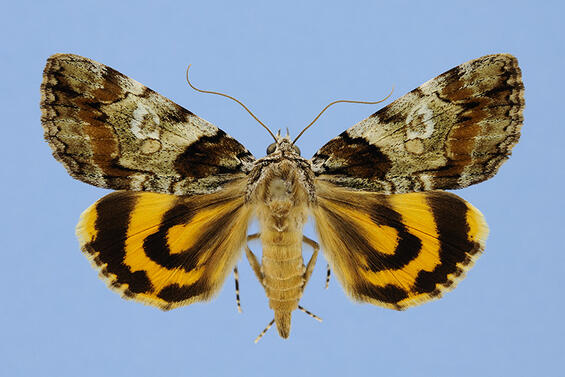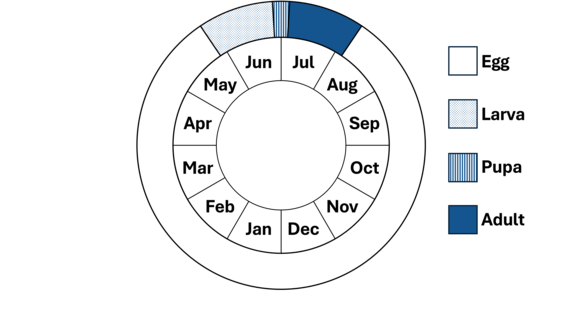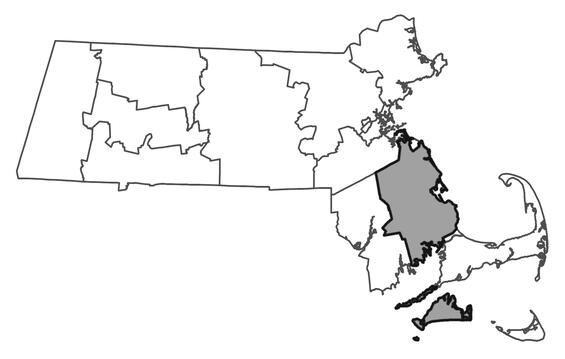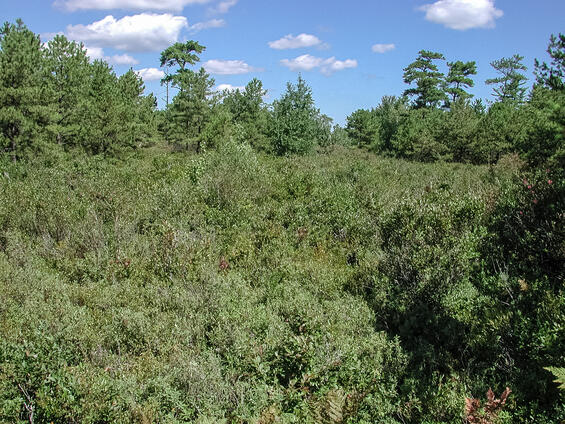- Scientific name: Catocala pretiosa
- Species of Greatest Conservation Need (MA State Wildlife Action Plan)
- Endangered (MA Endangered Species Act)
Description

Precious underwing moth (Catocala pretiosa)
The precious underwing (Catocala pretiosa) is an erebid moth with a wingspan of 37-42 mm (1.5-1.7 in). The median area of the forewing is white, extending from the costal margin to the inner margin. The median area is overlaid with olive green (especially in freshly-emerged individuals), transitioning to solid olive green towards the outer wing margin. The jagged postmedial and antemedial lines are black; the former margined with a medium brown band distally, the latter with dark brown shading proximally. Both a black basal dash and a black apical dash are present. The reniform spot is a white ring, and the subreniform spot solid tan. The hind wing is bright yellow to orange, with two black bands. In Massachusetts, the precious underwing is most similar to the charming underwing (Catocala blandula). However, the charming underwing has more gray to greenish-gray over the white median area (as well as the other lighter portions of the forewing), and the white of the median area does not extend to the inner margin of the forewing.
Life cycle and behavior
In Massachusetts, the precious underwing flies in July and early August. Eggs overwinter, hatching in the spring. Larvae feed on new foliage, flowers, and fruits of chokeberries (Aronia spp.), and pupate in late June or early July.

Distribution and abundance
In Massachusetts, the precious underwing is restricted to the southeastern part of the state. It is found more extensively in southern New Jersey, but the Massachusetts and New Jersey populations comprise the entire global range of the nominate subspecies, Catocala pretiosa pretiosa (Schweitzer et al. 2011).

Distribution in Massachusetts.
1999-2024
Based on records in the Natural Heritage Database.
Habitat
In Massachusetts, the precious underwing inhabits acidic riparian floodplain swamps, shrub swamps, shrubby bogs, and pond shores, often within coastal sandplain pitch pine-scrub oak barrens.
Healthy habitats are vital for supporting native wildlife and plants. Explore habitats and learn about conservation and restoration in Massachusetts.

Shrubby bog within pitch pine-scrub oak barrens, habitat for the precious underwing moth. Habitat managed by MassWildlife at Southeast Pine Barrens Wildlife Management Area.
Threats
The precious underwing is threatened by habitat loss and hydrologic alteration that disrupts the natural seasonal flooding of its habitat. Other potential threats include invasion by exotic plants, introduced generalist parasitoids, eutrophication or other water pollution, riverbank armoring, aerial insecticide spraying, non-target herbicide application, excessive deer browse of larval host plants, and off-road vehicles. A warming climate may be detrimental to the nominate subspecies (Catocala pretiosa pretiosa), as its range has a very narrow latitudinal extent, extending south only to New Jersey. Northward range expansion may be possible, though this has not yet been documented.
Conservation
Land protection and habitat management are the primary conservation needs of the precious underwing moth in Massachusetts. In particular, acidic riparian floodplain swamps, shrub swamps, shrubby bogs, and pond shores should be conserved, restored, and managed to maintain habitat for this species and other species dependent on such habitat.
Survey and monitoring
The distribution of the precious underwing in Massachusetts is relatively well documented; however, it is possible that there are a small number of undiscovered populations. Known populations of this species should be surveyed to document persistence at least once every 25 years; every 10 years is more desirable when practicable.
Management
Management of acidic riparian floodplain swamps, shrub swamps, shrubby bogs, and pond shores should include restoring and/or maintaining natural hydrology and control of invasive exotic plants. Shrub thickets in these habitats should be maintained and the chokeberries (Aronia spp.) promoted. Habitat condition should be monitored and management adapted as needed.
Research needs
The natural history and conservation needs of the precious underwing are relatively well known. However, the future effects of a warming climate on this species are unpredictable and should be documented.
References
Schweitzer, D.F., M.C. Minno, and D.L. Wagner. 2011. Rare, Declining, and Poorly Known Butterflies and Moths (Lepidoptera) of Forests and Woodlands in the Eastern United States. Forest Service, U.S. Dept. of Agriculture, Washington, DC. 517 pp.
Contact
| Date published: | March 21, 2025 |
|---|